

Our LM adapter solutions bring the Wild M450 epi macroscope into the digital world.
Representing the manufacturer’s top of the line at the time, the macroscopes made by Wild Heerbrugg AG feature high-grade optical systems and a smart, functional design. Before it became part of Leica Microsystems in 1997, Wild had its corporate headquarters in Switzerland and exported its products all over the world from there. The optical instruments made by Wild were designed to optimally meet the requirements of professional areas of application, and the company also offered a wide range of accessories. For this reason, they are still commonly found in use at universities, research laboratories and large companies.
Because these scopes are so popular, we offer a specially designed optical adapter solution for attaching modern digital cameras to the Wild M400, M420 and M450 macroscopes. By combining a Wild macroscope with our LM adapter solution with built-in optics and the latest camera technology, you can achieve excellent image quality that is in no way inferior to that of the latest scopes currently offered on the market. This way, you can configure this macroscope classic for efficient use in the digital age.
The Wild macroscopes, which are actually a hybrid of a macroscope and a laboratory microscope, have low magnification (zooming lens) and only one light path right through the middle (centric light path), which makes them ideal for high-quality photographic documentation. The single optical path eliminates the lateral shift problems and distortions you get with stereo microscopes that have angled optical paths inclined at 15 degrees, which means that the image quality is much better, without blurring at the edges. The Wild macroscopes also work good for focus stacking – a digital image processing technique that combines multiple images taken at different focal distances (up to 100 individual frames) into a stack of images, which is then processed with a special software, such as Helicon Focus, to create one composite image. This photomerging gives you a much higher depth of field as well as significantly better resolution.
The demo photo below shows a reflected light image of a semiconductor at 50x total magnification, taken with a Nikon SLR camera with a full-frame sensor.
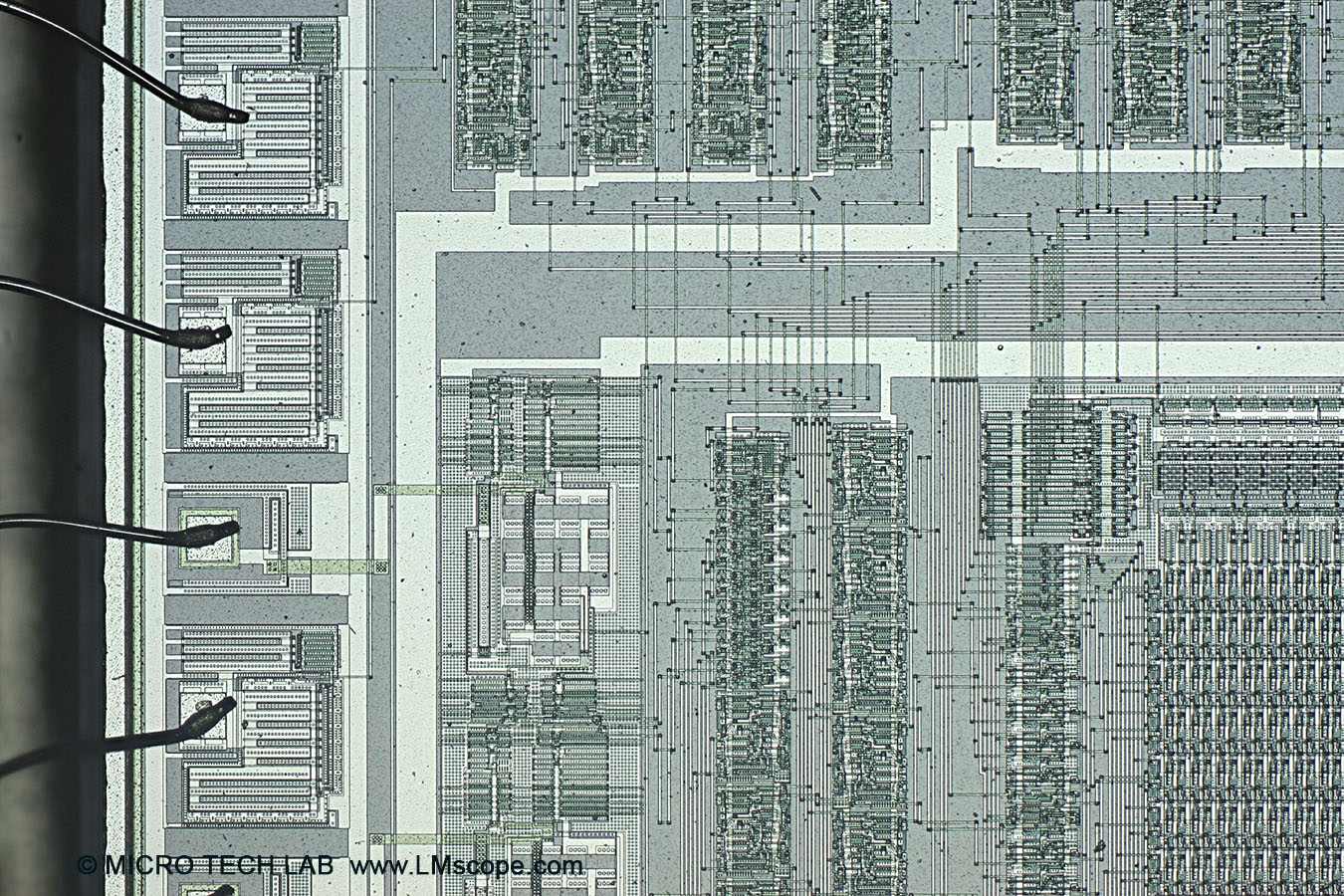
What makes the macroscopes from Wild so successful?
- Swiss quality optics
- Objective lenses with high numerical aperture; Wild also produced APO lenses
- Short working distance of 35 mm (remains constant over the entire magnification range)
- Robust mechanical construction
- Central optical path
- Variable iris diaphragm
Due to its short working distance (35 mm), the objective lens has a higher resolution:
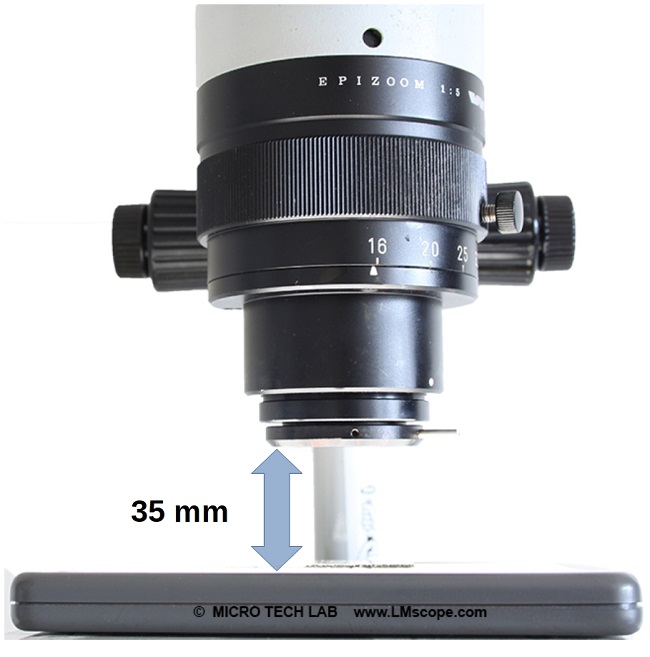
The macroscope has a 6V/20W coaxial halogen illuminator, so even fine structures show up in strong contrast.
The central aperture diaphragm, which can be adjusted manually, adds flexibility and power to the Wild M450. The aperture setting is very important for image quality, which is why we recommend that at least the second aperture stop should be used. Together with the central optical path, it is easy to find the optimum balance of resolution and depth of field. If the iris diaphragm is opened completely, the objective is functioning at maximum aperture. If it is closed, the depth of field is increased.
The image below shows the aperture diaphragm in the opened and closed positions. We removed the objective lens to provide a better view, especially of the central iris diaphragm that controls the aperture:
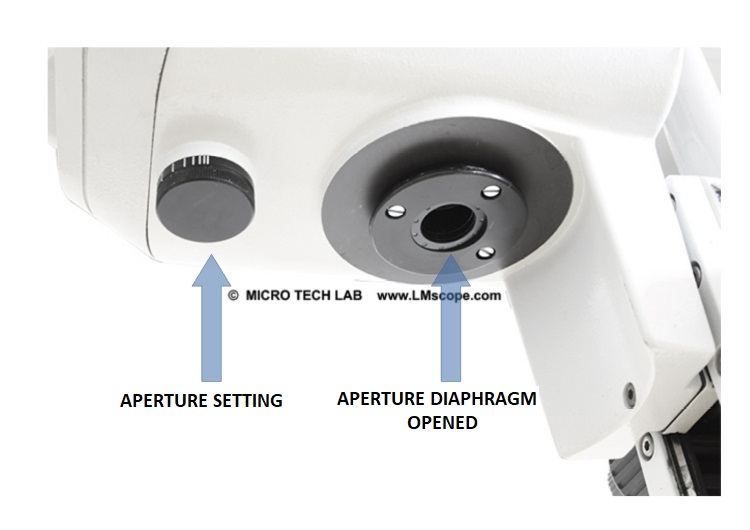
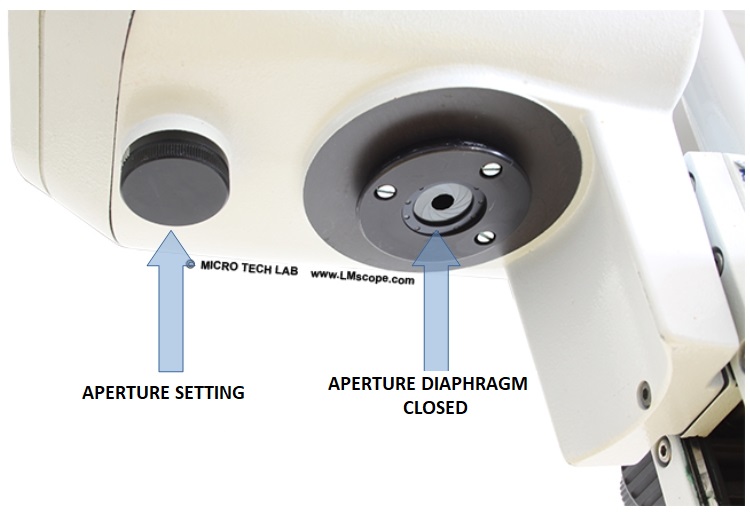
The macroscope has an Epizoom lens with a zoom range of 1:5. The lens shown below has the lowest magnification. It provides a field of view (FoV) of 22 mm x 14.6 mm; at the highest zoom level, an FoV of 4.2 mm x 2.8 mm can be achieved.
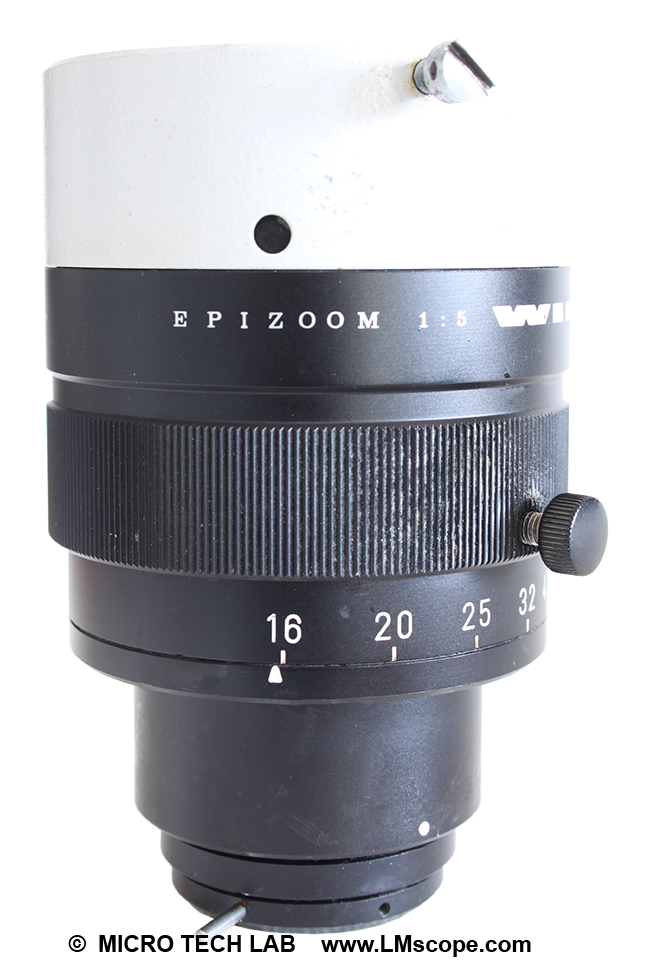
Unfortunately, the standard version of the M450 does not have a separate phototube. The incident illuminator is located above the macroscope head. In our example application, we removed the illumination unit and attached an LM adapter solution with a cover plate to the optical port, which we developed especially for this macroscope. Instead of the built-in incident light illuminator, an external light source (e.g. LED spot with gooseneck) can be attached. If you have an elbowed phototube (with beam splitter), you can find the right adapter solution here.
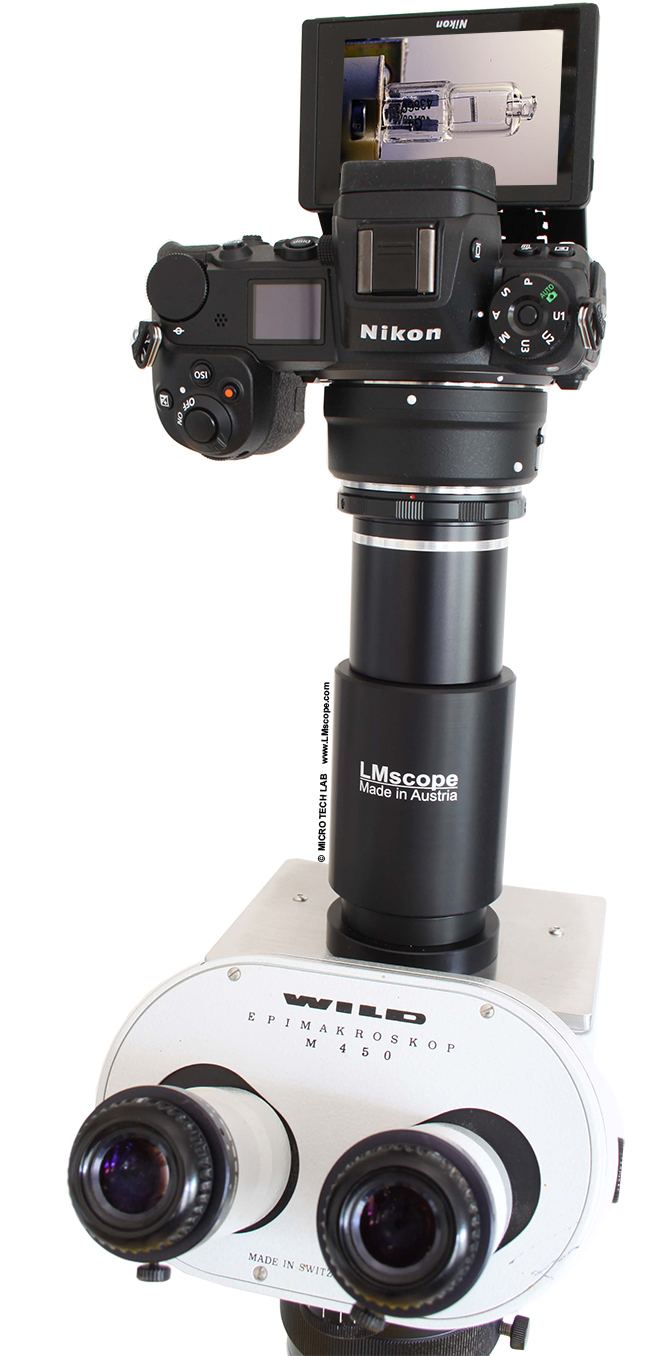
We generally recommend DSLR and system cameras because they can be controlled remotely from a PC/Mac and even from a tablet or smartphone via Live View, which makes working with the macroscope a lot easier.
The following features are important when it comes to selecting the right camera:
- Large sensor (APS-C or full-frame) with high resolution
- Remote control software for PC/Mac or remote control app for tablet/smartphone
- Full HD or 4K video
- Vari-angle display
- HDMI port
- Extensive dynamic range
- Charging via USB or dummy battery
- Wi-Fi
If the scope doesn’t have a phototube or if the phototube is used for other purposes, the adapter can also be attached to the eyepiece tube (with a viewing angle of 30 degrees and interpupillary distance adjustment).
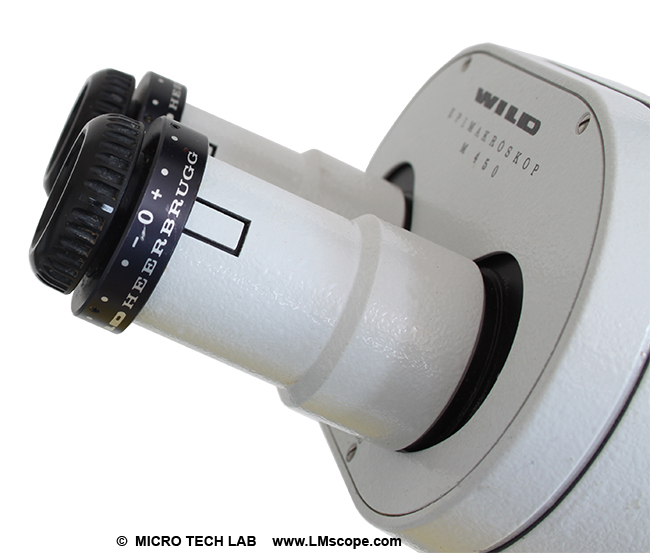
For this, one eyepiece is removed …
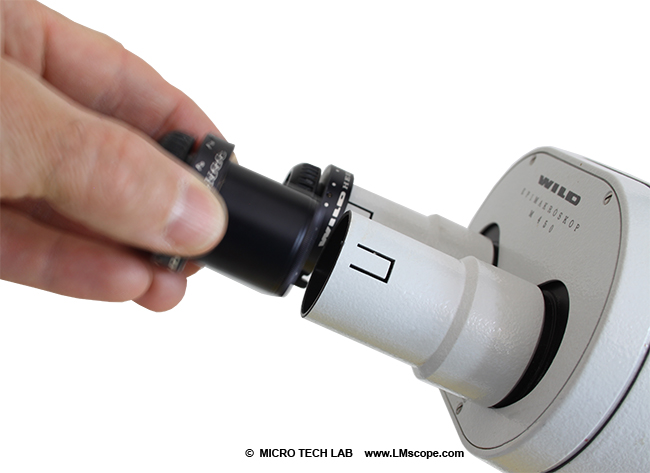
… and the adapter is put into its place.
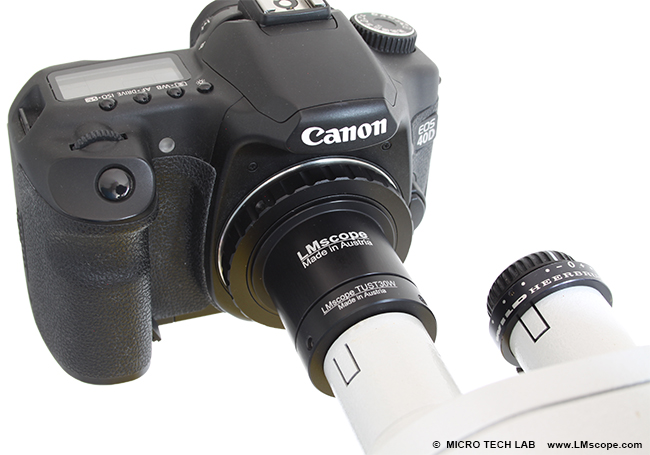
Because the head and the stand of the macroscope have been designed as separate units, it can be used with different types of stands, depending on the observation needs in each case. Stands with incident or transmitted light units, with inclined illumination on the side or coaxial polarised lighting from above, and with a fixed base or a swinging arm are available.
CONCLUSION: The Wild M400 series macroscopes are excellent optical instruments. With our LM adapter solutions, they can be coupled with modern digital cameras in a few easy steps. If you already have a Wild macroscope, you can choose from a wide range of digital cameras that are great fits for your device. Further information on making a camera selection can be found on the following two info pages: camera recommendations and camera ranking.
If you are interested in our adapter solution, please get in touch with us. We will gladly provide custom advice on which camera would be best for your needs.
Photography:
Fitting the microscope to digital single-lens reflex (DSLR), mirrorless interchangeable-lens cameras (MILC ), digital single-lens mirrorless (DSLM) or C-mount cameras is easy with our LM digital SLR adapters, which feature a plan achromatic optical system. Our products make it possible to capture top-quality microscope images. To help you select the adapter that is right for your camera, we have set up an online configurator on our website. You can also email us – ideally with attached photographs of your microscope.
Modern DSLR and single-lens mirrorless (DSLM) offer the latest technology and are generally very well suited for microscopy applications. Most of them can be controlled remotely via PC/Mac. Because of their high sales volumes, they offer an excellent price/performance ratio compared to special-purpose microscope cameras.
Features of top DSLR and single-lens mirrorless cameras (DSLM):
- Large, powerful full-frame sensors (36 x 24 mm)
- Sensor resolution of 61 megapixels or 240 megapixels with Pixel Shift technology
- High light sensitivity (ISO 400,000+)
- Extensive dynamic range (up to 15 aperture stops/f-stops)
- Short exposure times (1/8000 second) up to 1/32,000 seconds using the digital shutter
- 4K Ultra HD or 8K Ultra HD video function
- Live video capture on external monitors in ultra HD quality
In most cases, these cameras are significantly more powerful than microscope cameras with smaller sensors (1/2" or 2/3"). On our website you will find our current camera recommendations and a camera ranking which is specifically tailored to microscopy applications.